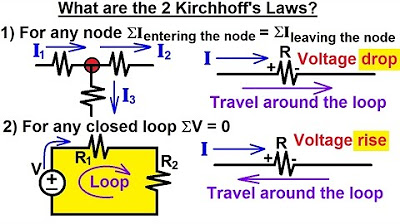Hukum 2 kirchoff rangkaian 2 loop
Summary
TLDRThis video tutorial explains Kirchhoff's Second Law in the context of a two-loop electrical circuit. The presenter walks through the application of two key formulas: the sum of EMFs and voltage drops (ΣEMF + ΣIR = 0) and the potential difference between two points (Vab = ΣEMF + ΣIR). Using a practical circuit example with batteries and resistors, the video demonstrates step-by-step how to assign current directions, apply Kirchhoff's laws, and solve the resulting system of equations to find the currents and potential differences in the circuit. The video provides a clear, methodical approach to understanding complex circuit analysis.
Takeaways
- 😀 Kirchhoff's Second Law (KVL) states that the sum of voltages around any closed loop in a circuit is equal to zero.
- 😀 The KVL formula for current calculation is: ΣGGL + ΣI×R = 0, which involves accounting for both electromotive forces (batteries) and resistive voltage drops.
- 😀 For voltage calculations between two points, use the formula: V_ab = ΣGGL + ΣI×R, which applies to an open circuit.
- 😀 When applying KVL, the sign conventions for GGL are important: if the current meets the positive terminal first, it is positive; if the negative terminal is first, it is negative.
- 😀 Direction of assumed current is critical. If the calculated current is positive, it means the current flows in the assumed direction, but if negative, it flows in the opposite direction.
- 😀 A two-loop circuit can be analyzed by dividing it into two closed loops, and applying KVL to each loop separately to find the currents.
- 😀 If currents in different parts of the circuit meet at a junction, the total current is the sum of the individual currents in that branch.
- 😀 For solving systems of equations derived from KVL, use methods like substitution or elimination to find the currents in each loop.
- 😀 Negative current values indicate that the actual direction of current is opposite to the assumed direction.
- 😀 When calculating the total current in a resistor shared by multiple loops, sum the individual currents flowing through that resistor, taking care to account for their directions.
- 😀 In the example problem, after solving, the current in each loop is found to be 0.2 A in opposite directions, and the voltage between two points is calculated to be 2.4 V.
Q & A
What is Kirchhoff's second law used for?
-Kirchhoff's second law is used to analyze electrical circuits, specifically for calculating the currents and potentials in closed loops, ensuring the sum of voltage differences and electromotive forces (EMFs) equals zero.
What is the formula for Kirchhoff's second law?
-The formula for Kirchhoff's second law is ΣGGL + ΣQR = 0 for current analysis, and Vab = ΣGGL + ΣIR for voltage differences between two points.
How do we determine the direction of current in a loop?
-The direction of the current is determined by the sign of the calculated current. If the current is positive, the direction follows the loop's assumed direction. If negative, the current flows in the opposite direction.
What does a negative value for current indicate in terms of direction?
-A negative current value indicates that the actual current flows in the opposite direction to the initially assumed direction of the loop.
How is the EMF sign determined in a circuit?
-The sign of the EMF is determined based on the first encounter of the current arrow with the battery terminals. If the current arrow first meets the positive terminal, the EMF is positive. If it first meets the negative terminal, the EMF is negative.
How do you set up a circuit with two loops for analysis?
-To analyze a circuit with two loops, assign labels to the points in the circuit, split it into two loops, and apply Kirchhoff's second law to each loop, taking into account the direction of currents and the components in each loop.
Why is it better to assume one loop moves clockwise and the other counterclockwise?
-Assuming one loop moves clockwise and the other counterclockwise simplifies the analysis and avoids complexity in solving the equations, making the process more straightforward.
What is the significance of the sign of current in the analysis?
-The sign of the current helps determine the actual direction of flow in the circuit. A positive current indicates the flow follows the assumed loop direction, while a negative current indicates the flow is opposite.
What is the method used to solve the simultaneous equations for currents?
-The method used to solve the simultaneous equations for currents is either elimination or substitution. In this case, the elimination method was used to solve for the currents in both loops.
How do you calculate the potential difference between two points in the circuit?
-To calculate the potential difference between two points, use the formula ΣGGL + ΣIR, where GGL is the electromotive force and IR is the product of current and resistance along the path between the points.
Outlines

This section is available to paid users only. Please upgrade to access this part.
Upgrade NowMindmap

This section is available to paid users only. Please upgrade to access this part.
Upgrade NowKeywords

This section is available to paid users only. Please upgrade to access this part.
Upgrade NowHighlights

This section is available to paid users only. Please upgrade to access this part.
Upgrade NowTranscripts

This section is available to paid users only. Please upgrade to access this part.
Upgrade NowBrowse More Related Video

Electrical Engineering: Basic Laws (8 of 31) What Are Kirchhoff's Laws?

Electrical Engineering: Basic Laws (11 of 31) Kirchhoff's Laws: A Medium Example 2

Hukum Kirchhoff Rangkaian 2 Loop : [CARA CEPAT] - Listrik Dinamis Fisika Kelas 12 Part 2

KVL and KCL (Circuits for Beginners #11)

Node Voltage Analysis (Circuits for Beginners #15)

Electrical Engineering: Basic Laws (9 of 31) Kirchhoff's Laws: A Simple Example
5.0 / 5 (0 votes)